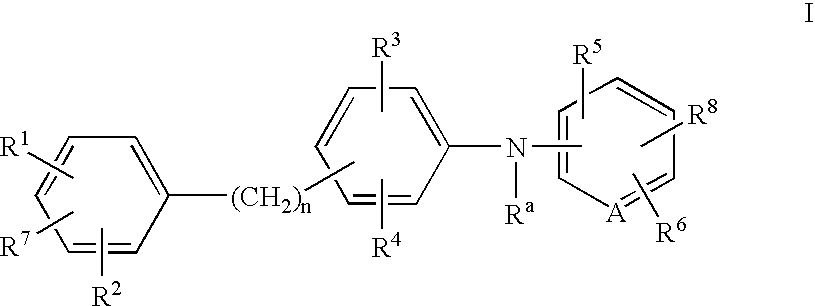Method of inhibiting amyloid protein aggregation and imaging amyloid deposits
a technology of amyloid protein and amyloid aggregation, which is applied in the field of inhibiting amyloid protein aggregation and imaging amyloid deposits, can solve the problems of inability to directly image amyloid deposits in vivo, the difficulty of direct imaging of amyloid deposits, and the failure of attempts to image amyloid deposits directly using magnetic resonance imaging and computer-assisted tomography,
- Summary
- Abstract
- Description
- Claims
- Application Information
AI Technical Summary
Benefits of technology
Problems solved by technology
Method used
Image
Examples
example 1
Preparation of 2-{4-[2-(3,4-Dichlorophenyl)ethyl]phenylamino}-benzoic acid
Step A (Scheme 1): Preparation of 1,2-Dichloro-4-[2-(4-nitrophenyl)ethenyl]-benzene
[0508]A mixture of p-nitrophenylacetic acid (51.23 g, 0.28 mol) and 3,4-dichlorobenzaldehyde (49.50 g, 0.28 mol) in piperidine (50 mL) was heated to 150-160° C. for 5 hours under a N2 atmosphere. After cooling the reaction mixture, the precipitate was triturated in boiling methanol (MeOH) (50 mL) and then cooled to −5° C. for 12 hours. The crystalline precipitate was filtered off, rinsed with cold MeOH and dried at room temperature in a vacuum oven overnight to yield an orange solid, 22.71 g (0.077 mol, 27%) of the desired product.
[0509]mp 190-191° C. MS:294.9 (M+).
Step B (Scheme 1): Preparation of 4-[2-(3,4-Dichlorophenyl)ethyl]benzenamine
[0510]A sample of 1,2-dichloro-4-[2-(4nitrophenyl)ethenyl]benzene (98.0 g, 0.33 mol) in tetrahydrofuran (THF) (1.6 L) was reduced in the presence of Raney Nickel (Ra—Ni) (20 g) at 25° C. to 40...
example 2
Preparation of 2-{4-[2-(3,4-Dichloro-phenyl)-ethyl]phenylamino}-5-nitrobenzoic acid
Step C (Scheme 6): Preparation of 2-{4-[2-(3,4-Dichloro-phenyl)-ethyl]phenylamino}-5-nitrobenzoic acid methyl ester
[0518]A mixture of 4-[2-(3,4-dichlorophenyl)-ethyl]benzenamine (600 mg, 2.25 mmol), 2-bromo-5-nitrobenzoic acid methyl ester (489 mg, 1.88 mmol), cesium carbonate (857 mg, 2.62 mmol), tris(dibenzylideneacetone-dipaladium(0) (51 mg, 0.056 mmol) and (S)-(2,2′-bis(di-p-tolylphosphino-1,1′-binaphthyl (98%, (S)-tol-BINAP) (58 mg, 0.085 mmol) (Ligand / Pd=1.5) in anhydrous toluene (16 mL) was heated to 100° C. for 12 hours under N2. After cooling, the reaction mixture was diluted with ether, filtered through celite and rinsed thoroughly with ether. The filtrate was evaporated to dryness to give a brown residue. Purification by flash chromatography (silica gel, 5% EtOAc / hexane) yielded 540 mg (1.21 mmol, 64%) of the desired product. mp 107-108° C.
[0519]Analysis for C22H18N2Cl2O4: Calcd: C, 59.34; ...
example 3
Preparation of 2-{4-[4-(3,4-Dichloro-phenyl)-ethyl]phenylamino}-4-methoxy-5-nitrobenzoic acid
[0522]To a cooled (−78° C.) solution of 4-[2-(3,4-dichloro-phenyl)-ethyl]phenylamine (0.836 g, 3.14 mmol) in THF (20 mL), LHDMS (6.28 mL, 1 M in THF, 6.28 mmol) was added dropwise. The reaction mixture was allowed to stir at −78° C. for 10 minutes. A solution of 2-flouro-4-methoxy-5-nitrobenzoic acid methyl ester (0.72 g, 3.14 mmol) in THF (30 mL) was added dropwise, and this solution was stirred for 30 minutes at −78° C. The reaction mixture was allowed to gradually warm to room temperature and stir for 2 hours under a N2 atmosphere. The reaction mixture was diluted with ethyl acetate (EtOAc), and acidified with 5N HCl (pH 3). The organic layer was dried (Na2SO4), filtered and concentrated in vacuo to yield a brown residue. To a solution of this residue in EtOH (20 mL) and THF (40 mL), 5N NaOH (50 mL) was added, and the mixture was refluxed for overnight The solvent was removed in vacuum, a...
PUM
| Property | Measurement | Unit |
|---|---|---|
| body weight | aaaaa | aaaaa |
| pH | aaaaa | aaaaa |
| pH | aaaaa | aaaaa |
Abstract
Description
Claims
Application Information
 Login to View More
Login to View More - R&D
- Intellectual Property
- Life Sciences
- Materials
- Tech Scout
- Unparalleled Data Quality
- Higher Quality Content
- 60% Fewer Hallucinations
Browse by: Latest US Patents, China's latest patents, Technical Efficacy Thesaurus, Application Domain, Technology Topic, Popular Technical Reports.
© 2025 PatSnap. All rights reserved.Legal|Privacy policy|Modern Slavery Act Transparency Statement|Sitemap|About US| Contact US: help@patsnap.com



